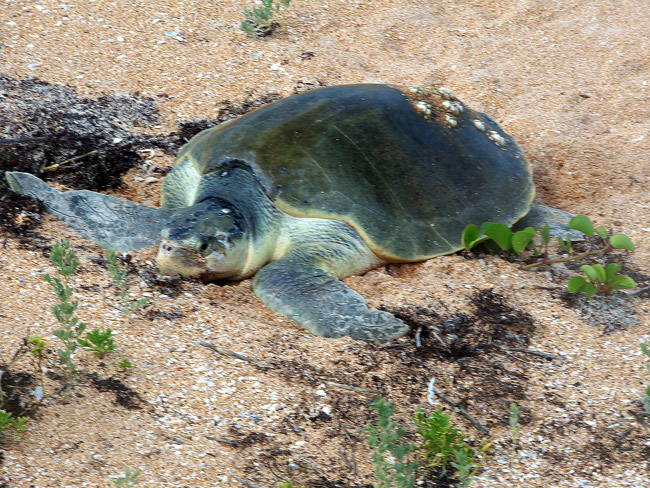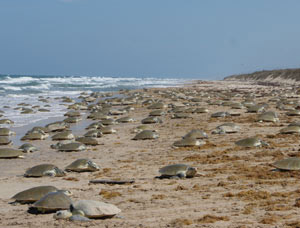
The sea turtle came ashore in Beverly Beach, just two houses north of my home, on a stormy, blustery afternoon in June.
 Kemp’s ridley turtles generally stay within the Gulf of Mexico region, with only the infrequent traveler to the east coast of the United States. This year Kemp’s ridleys nested in both Virginia and North Carolina and, to the glee of the Volusia Flagler Turtle Patrol, that one made a special stop in Flagler County. Since the 1980s, this is only the sixth Kemp’s ridley nest documented in Florida, and the first in Flagler County.
Kemp’s ridley turtles generally stay within the Gulf of Mexico region, with only the infrequent traveler to the east coast of the United States. This year Kemp’s ridleys nested in both Virginia and North Carolina and, to the glee of the Volusia Flagler Turtle Patrol, that one made a special stop in Flagler County. Since the 1980s, this is only the sixth Kemp’s ridley nest documented in Florida, and the first in Flagler County.
To the benefit of all who are interested in turtles, a visitor from Georgia was outside overlooking the beach and caught it all on camera.
Eli Brown, the son-in-law of homeowners Gary and Chris Lee, was vacationing with his wife Amanda and new-born child at the Lees’ oceanfront home. Eli was shocked to see the turtle emerge from the surf and slowly crawl toward the dune. Grabbing his smartphone, he took still and video images while watching this extremely special occasion. Neither Eli nor his family knew what species of sea turtle this was but, with the help of the Turtle Patrol, they later found out that he had captured a rare event.

Kemp’s ridley (Lepidochelys kempi) are the smallest sea turtles, weighing in at about 100 pounds and having a carapace or shell only two feet long. While onetime numbering about 40,000, the Kemp’s ridley population dropped precipitously between 1947 and 1966 to as few as 2,000, largely because of egg harvesting, the occasional harvesting of adults and subadults, and drowning deaths in shrimp trawler nets. Because this sea turtle primarily nests in one area near Rancho Nuevo, Tamaulipas, Mexico, scientists were able to obtain accurate counts during the massive nesting events, called arribadas, where females rushed ashore to dig nests and drop their eggs.
Since 1966, and largely because of government protection of the Tamaulipas nesting grounds and the introduction of turtle extruder devices (TEDs) in American shrimping fleets, the population has increased yearly and is now approaching less critical numbers.
The turtle that came ashore in Beverly Beach dug a shallow pit, dropped her eggs, covered them with sand, and headed back to the ocean home from which she had emerged some thirty minutes before. Eli caught it all, including the storm raging offshore. An interesting note is that Kemp’s ridleys often come ashore to nest during the day and frequently do so in windy or rainy weather. This momma was fulfilling her history right on cue.
Eli provided his pictures and video to the Turtle Patrol and gave permission for it to be viewed by all. In fact, the videos are now on YouTube.
(fOUR videos below show the sea turtle emerging from the ocean, making her nest, and returning to the water. I hope you enjoy them.)
The Turtle Patrol’s Lori Ottlein reported that when the nest was evaluated (a cleaning process usually done three days after the hatchlings emerge) patrol members found that 52 eggs had hatched, 44 eggs had not, and 10 hatchlings had partially broken through the eggs (known as a “pip”) but were not successful.
In a future Coastal View I will give you a wrap-up of the 2012 sea turtle nesting season, which has been a pretty high count year for loggerheads, greens and leatherbacks. And one special Kemp’s ridley. Until then, be well and do something positive for the nature around you.
![]()
Frank Gromling is the owner of Ocean Publishing in Flagler Beach. Reach him by email here.





























Geezer says
Thank you Flaglerlive and Mr. Gromling for this wonderful article and video content!
Magnolia says
I really enjoyed this. Thanks!
patti bissonnette says
Amazing video. So educational…the kind of education you can’t experience in a book! Thank you for sharing Eli. The beautiful creatures are so important to our oceans and are so fascinating. So happy you got to experience this live. The timing was so lucky!! Enjoyed it very much and appreciate your time and caring enough to let us all view this amazing and mysterious event!!!
Paul Oliver says
I know Eli and Amanda very well. They are really into wildlife. This is a real saga that ends with a happy ending.